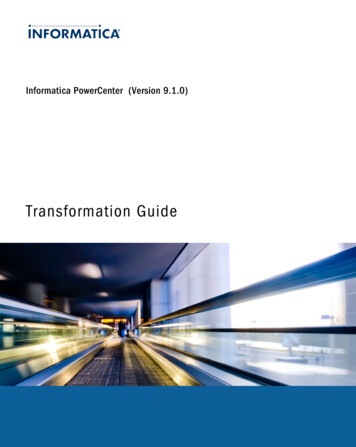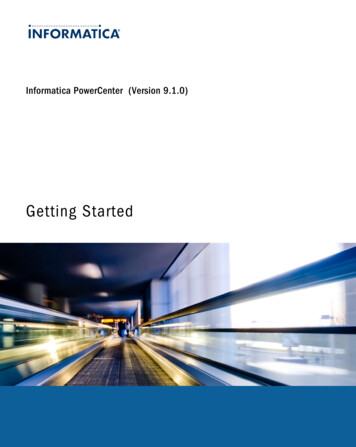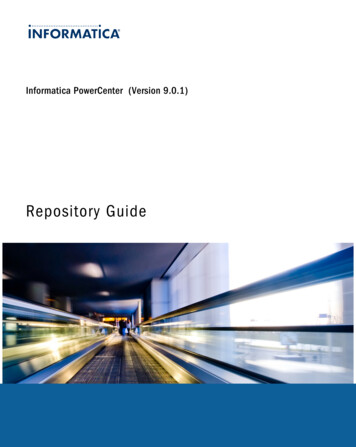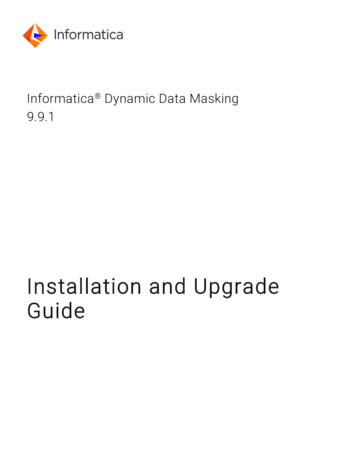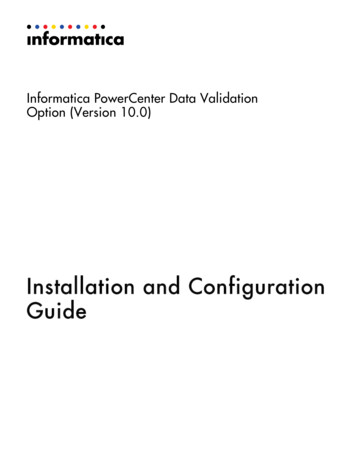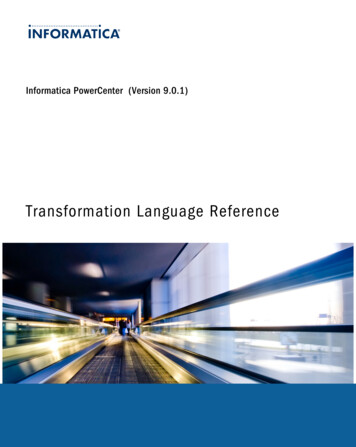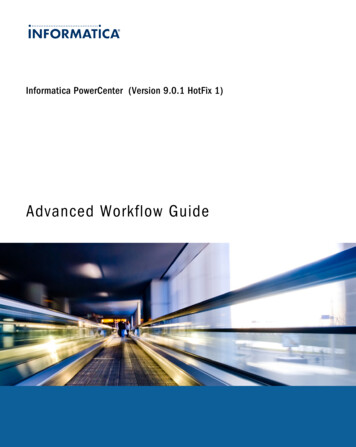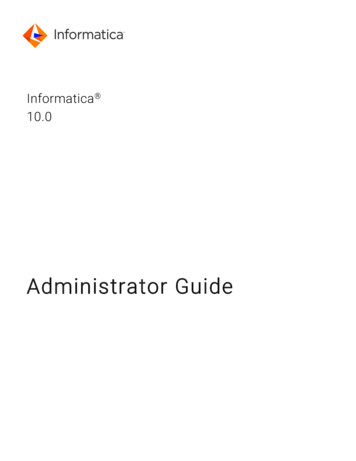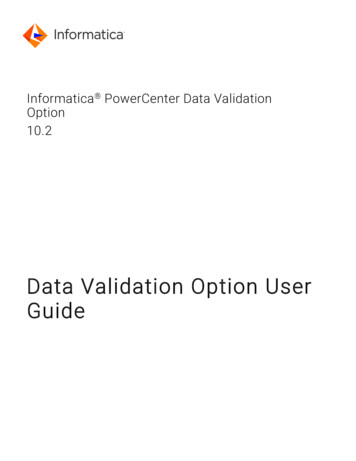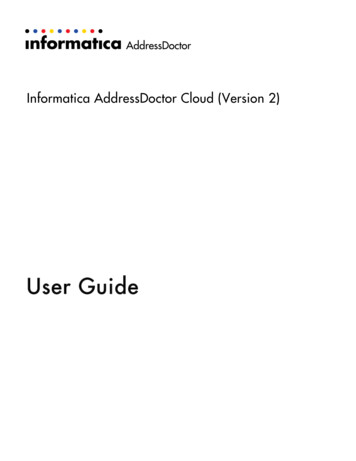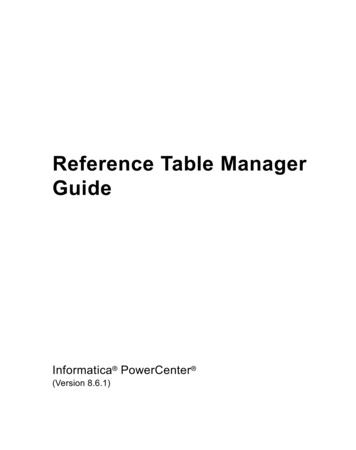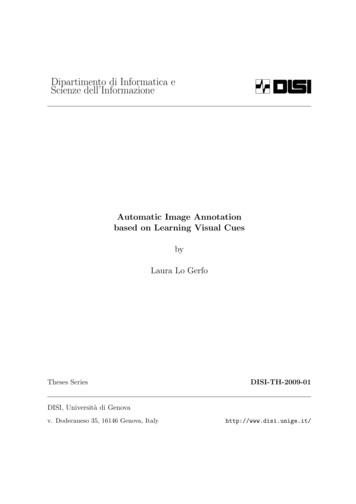
Transcription
Dipartimento di Informatica eScienze dell’InformazioneAutomatic Image Annotationbased on Learning Visual CuesbyLaura Lo GerfoTheses SeriesDISI-TH-2009-01DISI, Università di Genovav. Dodecaneso 35, 16146 Genova, Italyhttp://www.disi.unige.it/
Università degli Studi di GenovaDipartimento di Informatica eScienze dell’InformazioneDottorato di Ricerca in InformaticaPh.D. Thesis in Computer ScienceAutomatic Image Annotationbased on Learning Visual CuesbyLaura Lo GerfoFebruary, 2009
Dottorato di Ricerca in InformaticaDipartimento di Informatica e Scienze dell’InformazioneUniversità degli Studi di GenovaDISI, Univ. di Genovavia Dodecaneso 35I-16146 Genova, Italyhttp://www.disi.unige.it/Ph.D. Thesis in Computer Science (S.S.D. INF/01)Submitted by Laura Lo GerfoDipartimento di Informatica e Scienze dell’InformazioneUniversità degli Studi di Genovalogerfo@disi.unige.itDate of submission: February 2009Title: Automatic Image Annotation Based onLearning Visual CuesAdvisor: Alessandro VerriDipartimento di Informatica e Scienze dell’InformazioneUniversità degli Studi di Genovaverri@disi.unige.itExt. Reviewers:Massimo FerriDipartimento di MatematicaUniversità degli Studi di Bolognaferri@dm.unibo.itRoberto ManduchiDepartment of Computer EngineeringUniversity of California, Santa Cruzmanduchi@soe.ucsc.edu
AbstractEfficient access to digital images requires the development of techniques to search and organizethe visual information. While current technology provides several search engines relying ontextual description, the research on content-based image retrieval systems faces much morechallenging problems.Traditional databases exploit manual annotation for indexing and then retrieving the properimage collections. Although manual annotation of image content is considered a “best case”in terms of accuracy, it is an expensive and time-consuming process. As opposed to manualannotation, automatic annotation in large collections of data must deal with difficult issues.First, a “broad domain” of images has a virtually unlimited and unpredictable variabilityin appearance even for the same semantic meaning. Another crucial point is that the userinterprets an image identifying its semantic meaning by using a large amount of backgroundand context knowledge. An automatic annotation system instead is only able to quantify andprovide measurements by data processing and lacks the ability to infer information from thecontext.This thesis explores an automatic strategy for semantically annotating images of a largedataset. In the context of statistical learning, automatic annotation and retrieval can be castas classification problems where each class is defined as a group of image regions labeled witha common semantic keyword. The proposed framework is based on region-level analysis thatis a good compromise between local and global approaches. We use an unsupervised learningstrategy to organize the data in homogeneous clusters. In order to establish a connectionbetween the natural language and the region descriptors we assign tags to some clusters andapply a supervised algorithm on each cluster. We then employ an architecture of classifiersable to automatically assign a set of labels to a given image and to retrieve a subset ofrepresentative images belonging to a specific semantic class.The main contribution of this work is an effective architecture that could be expanded easilyto add new semantic concepts. Extensive experiments of the proposed approach are ongoingon large databases of natural and outdoor images, commonly used to test context-basedretrieval systems. The experimental results obtained so far confirm the potential of theproposed approach.
To Anna and Sofia,images of my past and my future
I never read, I just looked at pictures.(Andy Warhol)
Table of ContentsChapter 1 Introduction51.1Motivations and background . . . . . . . . . . . . . . . . . . . . . . . . . . . .51.2Objectives and contributions . . . . . . . . . . . . . . . . . . . . . . . . . . .81.3Organization of the thesis . . . . . . . . . . . . . . . . . . . . . . . . . . . . .10Chapter 2 Feature-based representation and segmentation112.1Feature-based representation . . . . . . . . . . . . . . . . . . . . . . . . . . .122.2Similarity measures . . . . . . . . . . . . . . . . . . . . . . . . . . . . . . . . .262.3Image segmentation . . . . . . . . . . . . . . . . . . . . . . . . . . . . . . . .27Chapter 3 Unsupervised and supervised learning313.1Supervised vs. unsupervised learning . . . . . . . . . . . . . . . . . . . . . . .323.2Supervised learning . . . . . . . . . . . . . . . . . . . . . . . . . . . . . . . . .333.3Unsupervised Learning . . . . . . . . . . . . . . . . . . . . . . . . . . . . . . .423.4Clustering Analysis . . . . . . . . . . . . . . . . . . . . . . . . . . . . . . . . .44Chapter 4 Discovering concepts from tagged images494.1The algorithmic pipeline . . . . . . . . . . . . . . . . . . . . . . . . . . . . . .504.2Image-to-blobs decomposition . . . . . . . . . . . . . . . . . . . . . . . . . . .524.3Unsupervised categorization of blobs . . . . . . . . . . . . . . . . . . . . . . .574.4Automatic labeling . . . . . . . . . . . . . . . . . . . . . . . . . . . . . . . . .624.5Dataset issues and discussion . . . . . . . . . . . . . . . . . . . . . . . . . . .643
Chapter 5 Spectral learning with application to image annotation675.1Relationships between regularization and filtering . . . . . . . . . . . . . . . .685.2Spectral filtering . . . . . . . . . . . . . . . . . . . . . . . . . . . . . . . . . .695.3Regularized Least-Squares as a spectral filter . . . . . . . . . . . . . . . . . .705.4Properties of spectral filters . . . . . . . . . . . . . . . . . . . . . . . . . . . .715.5Filter algorithms . . . . . . . . . . . . . . . . . . . . . . . . . . . . . . . . . .735.6Algorithmic complexity and regularization path . . . . . . . . . . . . . . . . .765.7Application of supervised learning for the annotation and retrieval of images77Chapter 6 Experimental evaluation796.1Experimental analysis of spectral algorithms . . . . . . . . . . . . . . . . . . .806.2Experimental results on annotation and retrieval . . . . . . . . . . . . . . . .856.3Distributed computing for feature extraction . . . . . . . . . . . . . . . . . .94Chapter 7 Conclusions97Bibliography994
Chapter 1Introduction1.1Motivations and backgroundThe focus of this thesis is on the automatic annotation of natural images in large datasets orheterogenous collections. Examples of relevant applications of the work described in the following are the organization and indexing of huge web-based image repositories such as Flickror Picasa, which are expected to keep growing rapidly thanks to the continuous insertion ofnew data from the users.The correct annotation of images is indeed a challenging problem even for human beingsbecause it is not trivial – if not impossible at all – to assess objectively what correct meansin this context. Annotations may be based on different criteria such as color, texture, shape,size or other kinds of both semantic and spatial constraints. The specific balance among allsuch criteria depends on the user’s viewpoint and the specific class of images: this makesthe design and development of algorithmic strategies to image annotation an open researchproblem within the context of Content-based Image Retrieval (CBIR) and, more in general,of Computer Vision and Image Analysis.Actually, it is widely acknowledged among computer vision researchers that the achievement of proper solutions to this problem is cumbersome and requires interdisciplinary efforts.Therefore, it is not plausible for any single research program to lead to a definitive automaticannotation system. Nonetheless, a number of crucial subproblems may be addressed effectively, and the complete desired system is likely to be based on future integrations of all theresulting submodules.In the above context, the first general objective of our research work was to assess to whatextent unsupervised and supervised learning may contribute to successfully annotate naturalimages. Consequently, in order to make the first steps toward a comprehensive annotationsystem, we aimed at designing and implementing the first modules to extract meaningfulfeatures, discover the semantic concepts and learn to annotate from a set of examples.5
Before starting the specific contributions of our work and presenting the results we obtained,it is worth to make a brief overview of the research background in CBIR, focusing on themain open issues.CBIR in general refers to a broad spectrum of computer science technologies that help us tocreate, organize, store and efficiently access large collections of digital pictures by exploitingautomatically their visual content. From this generally accepted definition it follows clearlythat the scope of the research in CBIR is extremely wide. For example, it ranges fromthe problem of representing the semantic content of an image to the definition of suitableimage similarity functions or to the automatic selection of most relevant answers to queriesexpressed in terms of generic visual concepts. Also, in order to cope with the many aspectsof the problem an high level of expertise is required in different fields such as – for example –computer vision, machine learning and statistics, database engineering, or psychology. Indeed,as the type of queries allowed to the user by CBIR systems is becoming more and morecomplex – from the initial query-by-visual-example to the more sophisticated query-by-keywordand toward the long desired fully-content-based queries – the field requires an increasinglymultidisciplinary approach to the problems; this trend was already pointed out in [RV08].We refer the readers to [SWS 00] for a comprehensive survey of the most influential works inthe area up to 2000; while [DJL 08] reports the latest developments and contains insightfulcomments and discussions on open issues. In [WBB 06], the authors offer an interestingpanel discussion on some of the most controversial problems correlated to CBIR.As a consequence of the above considerations, it should be clear why design and development of an effective CBIR system are considered unanimously one of the most challengingproblems addressed by researchers in Computer Vision and Pattern Recognition in the lastdecade. Furthermore, it should come as no surprise that, despite the considerable amount ofresearch efforts reported in the two surveys some of the crucial issues – which in our opinionare extremely intriguing research problems – still remain undressed. As anticipated above,the work described in this thesis mainly focused on one of such issues, which is the role of supervised and unsupervised learning. More specifically, we investigated the use of unsupervisedlearning techniques for the automatic definition of semantic visual concepts, based on whichto create an algorithmic architecture comprising a pool of supervised classifiers for automaticannotation and, possibly retrieval.The deployment of machine learning and statistical methods for many aspects of CBIR hasemerged as an important trends in the recent years (see for example [CCMV07] and referencestherein). The most adopted learning paradigm is the supervised one, which proved to beeffective for separating images belonging to visually well separated conceptual categoriessuch as indoor from outdoor scenes, or cities and buildings from landscapes. The usualexperimental setup is based on selected training images either containing or not the conceptof interest, from which a pool of one-versus-all classifiers or a single multiclass classifier aretrained. Automatic learning has been used also to build adaptive feature vectors (often called“signatures” in this context) from images.6
Design and implementation of data dependent similarity functions have been convenientlyaddressed in a semi-supervised learning framework by means of feedback loops in which theuser tunes the relevance of query results.The results obtained so far in many cases by such (semi-)supervised learning modules havebeen satisfactory however it is widely acknowledged that the generalization capabilities reachedby current CBIR systems are limited. In fact, in general system developers exploit manualannotation for indexing the images and then retrieving the proper image from the collection.Therefore, the training stage depends strongly on these manual indexes, which are used asinput labels. However, although manual annotation of image content is certainly the “bestcase” in terms of accuracy, it is prone to (at least) two limiting factors. On one hand, itis highly subjective and the choice of the proper set of tags for an image depends not onlyon the objects/concepts present in the foreground of the image but also on the backgroundcontext. This may result in two images containing the same object being annotated in twodifferent ways. On the other hand, the process of annotating a large collection of image datais a time-consuming process and human users tend to make errors while performing longand repetitive tasks. Such unavoidable errors result in poorer performances of the classifiers.Indeed, it follows that the strategy adopted to create annotations may be the main drawbackof many current systems.A further issue related to the annotation process is that it worsens rapidly as the search domaingoes from narrow to broad. Indeed, [SWS 00] already called attention to the crucial issue ofthe scope of the image search domain. CBIR systems designed for very narrow domains dealswith images that have limited variability and better-defined visual characteristics – which areeasily captured and summarized by human users in the annotation process. At the oppositeextreme, quite broad domains are likely to contain highly variable subtypes of images and therelated semantic concepts are more subjective and unpredictable – as consequence of whichgeneralization is a much more challenging goal.According to the previous analysis, we strongly believe there is a need for automatic strategies in the annotation process as viable alternatives to the traditional human-based manualannotation. Such automatization is likely to provide more flexibility to the consequent CBIRsystems.However, as opposed to manual annotation, automatic annotation in large collections of datamust deal with difficult issues. First, a “broad domain” of images has a virtually unlimitedand unpredictable variability in appearance even for the same semantic meaning. Anothercrucial point is that the user interprets an image identifying its semantic meaning by using alarge amount of background and context knowledge. An automatic annotation system insteadis only able to quantify and provide measurements by data processing and lacks the abilityto infer information from the context. This important issue is closely related to the so-calledsemantic gap – which is almost always present in machine vision systems – consisting in a lackof coincidence between information extracted from visual data and the interpretation that the7
same data has for a user in a given situation. A verbal description of a scene is contextualand depends on the knowledge of the observer whereas the image lives by itself. All theseaspects are crucial and must be kept in mind during the evaluation of the performances of anannotation system.1.2Objectives and contributionsThe long term objective of the thesis is to design an automatic system for semantic annotation and retrieval of natural images in large datasets. Specific attention is devoted to bothunsupervised and supervised learning aspects, in relation to which we present two originalcontributions in context of spectral methods in statistical learning theory. Detailed descriptions of such contributions are in Chapters 4 and 5.By integrating a suitable region-based image representation with the above learning modules,we propose an algorithmic framework for annotation and retrieval consisting of several classifiers in which classes are defined as groups of image regions labeled with common semantickeywords.In order to create and train the system, an unsupervised learning strategy is adopted to organize the data in homogeneous clusters, and assign automatically a tag to all the image regionsbelonging to meaningful clusters only. Therefore, we tried to establish a direct connection between possible natural language queries and the visual appearance of spatially localized partsof images, by means of which we trained an architecture of classifiers able to automaticallyassign a set of labels to a given image and – consequently – to retrieve representative imagesbelonging to the same semantic class.In order to cope efficiently with the difficulties arising while building the above system, wedesigned a modular system, which is also more likely adaptable to different annotation and retrieval scenario. The main modules of the algorithmic architecture – and the specific problemsconnected to them – are briefly summarized in the following list. Image Segmentation. In many annotation and retrieval systems segmentation is used aspreprocessing stage before extracting features. Although segmentation is widely used,highly accurate image segmentation is hard to achieve, if not impossible. There are twoaspects to be considered about image segmentation. The first is that there are manypossible partitions of the image and there are several correct segmentation, depending onthe application. The second aspect is that in broad domains clutters and occlusions areto be expected. Segmentation algorithms providing fine decomposition could excessivelyfragment the scene. A weak segmentation, yielding homogeneous regions not necessarilycovering entirely objects in the scene, is more adequate when handling large datasets.In the proposed system we obtain a weak image partition by means of a texture-colorsegmentation algorithm [HGS05]. This method, well-defined from a physical point of8
view, measures color/texture by embedding the responses of a filter bank into a coloropponent representation and exploits these measures to segment images. Feature Extraction and Data Representation. Feature extraction methods are useful tocapture visual properties of an image like color, texture, position, shape and salientpoints.We create a feature vector for each segment that includes the color, texture descriptionbut also models position in the image. We can identify two advantages concerning aregion-based approach. On the one hand global characterization alone cannot ensuresatisfactory retrieval results since that global features are often rigid to represent animage. On the other hand local feature extraction is computationally onerous and isnot well-suited to a retrieval system designed to serve a broad domain. Supervised and Unsupervised Approaches to Learning. Learning-based methods are fundamental to perform automatic annotation and to yield perceptually meaningful rankingof images as retrieval results. Clustering allows to automatically assign a set of tagsto images in the absence of labels. This approach is well-suited when handling large,unstructured image repositories. In order to discover meaningful subgroups that canbe likely associated to semantic concepts or sub-concepts, we determine clusters fromsegments previously computed.Therefore, for each set of clusters automatically annotated, we use a number of supervised learning machines that learns from the data to categorize all blobs extracted fromthe images in the database for the subsequent retrieval.The contributions of my research work can be summarized as follows: to design and develop an architecture of classifiers, each representing a visual conceptwhich could be possibly present in the image. The input feature vectors to the systemare not relative to the whole image but instead they are extracted from a pool of imageparts (which we will refer to as blob) obtained by coarsely segmenting the images usingcolor and textural information. to study, develop and validate experimentally an algorithmic pipeline which allows forthe automatic creation of training sets of blobs for each classifier by transferring priorknowledge given in the form of a tagging of the images. to study and implement an iterative spectral algorithm, called ν-method, which is usedas the algorithmic characterization of the visual concepts. ν-method belongs to a classof spectral classification algorithms which have been shown in [LGRO 08] to obtaingood results when compared with a number of more popular state-of-the-art classifiers. to use the above methods to make the first step towards a complete CBIR engine. Preliminary tests are performed on the standard benchmark database called COREL30K.9
The results of the experiments are promising, albeit preliminary thus requiring moreextensive analysis.1.3Organization of the thesisThe structure of the thesis is organized as follows: Chapter 2 is devoted to introduce visual cues and segmentation approaches in theimage domain. We discuss state-of-the-art of image representation methods focusingon those adopted in our work, mostly based on color and texture information. We alsopresent a taxonomy of some popular methods for image segmentation. Among these,we give particular emphasis and details on feature-based segmentation techniques. Chapter 3 briefly presents the relevant background pertaining to supervised in opposition to unsupervised learning techniques. We provide the main ingredients of supervisedlearning and introduce the regularization theory. Among unsupervised learning methods, the focus is on two popular data clustering techniques that we adopted in thepipeline of the system. Chapter 4 gives an overview of the whole procedure to infer semantic concepts totraining images. Starting from a general discussion on the setting, we move to explainthe requirements arising from the algorithmic standpoint. We introduce the stages toobtain image segmentation, feature vectors, and homogeneous clusters of blobs, thenthe approach to label each cluster. We also show results of this totally unsupervisedand automatic procedure for a well-known large dataset. Chapter 5 shows how a large class of regularization methods, collectively known asspectral regularization and originally designed for solving ill-posed inverse problems,gives rise to regularized learning algorithms. We present several examples of spectralalgorithms for supervised learning and discuss similarities and differences between thevarious methods. Finally we comment on their properties in terms of algorithmic complexity. Chapter 6 is devoted to experimentally validate the algorithms discussed in Chapter5, showing the effectiveness of the proposed approach. We apply them to a number ofclassification problems on sets of well known benchmark data, comparing the resultswith the ones reported in the literature; then we consider a more specific application,face detection, analyzing the results provided by a spectral regularization algorithmas opposed to a well-known learning technique. The second part of the chapter isdevoted to present a number of preliminary experiments using a large dataset to testthe potential of the spectral algorithms in the context of automatic image annotationand retrieval.10
Chapter 2Feature-based representation andsegmentationMost CBIR systems perform feature extraction as a preprocessing step. Once obtained,visual features act as inputs to subsequent image analysis tasks, such as similarity estimation,concept detection, or annotation. As previously discussed, the goal here is to automaticallydescribe the content of images. To do so, the image has to be represented in a suitable waypossibly discarding unnecessary information and the following step is to statistically assign itto a category. This can be done only if an appropriate similarity measure is defined.The simplest way to represent image information is to consider the image at pixel-level representation, but this choice is often not optimal because it does not emphasize any peculiarityof the considered image. Alternatively, one can take into account a list of features basedeither on global or local properties. Typically, we expect that a good representation for acertain task is the best compromise between loss of information and enhancement of imagecharacteristics.In this chapter we briefly present visual low-level features and their application to imagesegmentation. An introduction to basic concepts and methodologies on image features andsegmentation approaches can be found in [GW08]; surveys on image feature extraction inCBIR system can be found in [RHC99] and [DJL 08]. In Section 2.1, we briefly reviewthe state-of-the-art of image representation methods focusing on those adopted in our work,mostly based on color and texture information. In Section 2.2 we give an overview of someapproaches to compute similarity between images when one of the description discussed inthe previous sections is adopted.In Section 2.3 we present a taxonomy for image segmentation focusing on feature-based methods.11
2.1Feature-based representationA good feature should capture a certain visual property of an image, either globally for theentire image or locally for a small group of pixels.The feature is defined as a function of one or more measurements, each of which specifiessome quantifiable property of an object. We classify the various features currently employedas follows: Local features: features calculated over the results of subdivision of the image band onimage segmentation or edge detection. In a local description a pixel is represented bya set of features extracted in its neighborhood (e.g., average color values across a smallblock centered around the pixel). Global features: features calculated over the entire image or just regular sub-areas of animage. For instance, in a color layout approach, an image is divided into a small numberof sub-images and the average color components (e.g., red, green, and blue intensities)are computed for every sub-image. The overall image is thus represented by a vector ofcolor components where a particular dimension of the vector corresponds to a certainsub-image location.The advantage of global extraction is its high speed for both extracting features and computingsimilarity. However, global features are often too rigid to represent an image. Specifically,they can be oversensitive to location and hence fail to identify important visual characteristics.To increase the robustness to spatial transformation, an alternative approach relies on localextraction followed by a further step of feature summarization.An alternative categorization of image features can be based on the source of informationextracted. Low-level features are extracted directly from digital representations of objects,have little or nothing to do with human perception and can be extracted from the originalimages. High-level features are computed from basic data or low-level features; they representa higher level of abstraction and they are typically more concerned with the system as a wholeand its goals.In many applications, the representation of image data does not rely only on one type of cue.Conversely, two or more different cues are extracted, resulting in two or more correspondingvectors of features, one for each given image. A common practice is to organize the informationprovided by all these cues as the elements of one single vector, commonly referred to as afeature vector. The set of all possible feature vectors constitutes a feature space.In this section we report some of the most common methods for describing the image contentvia set of features. An exhaustive overview is out of the scope of this thesis, here we mainlyfocus on the most popular cues and descriptors that have been applied in the automatic12
annotation and retrieval context (see, for example, [Man96], [MrOVY01] and references in[DJL 08]): color, texture and shape.2.1.1Color representationColor is perhaps the most expressive of all the visual cues and has been extensively studiedin the image retrieval research.The visual experience of the normal human eye is not limited to gray scale, therefore coloris an extremely important aspect of digital imaging. In a very general sense, color conveysa variety of rich information that describes the quality of objects. The perception of color isallowed by the color-sensitive neurons known as cones that are located in the retina of theeye. The cones are responsive to normal light and are distributed with greatest density nearthe center of the retina, known as fovea. The rods are neurons that are sensitive at low-lightlevels and are not capable to distinguish color wavelengths. They are distributed with greatestdensity around the periphery of the fovea, with very low density near the line of sight. Inthe normal human eye, colors are sensed as near-linear combinations of long, medium andshort wavelengths which roughly correspond to the three primary colors that are used in thestandard video camera systems: Red (R), Green (G) and Blue (B).Figure 2.1: Schematic diagram of the human eye.13
As a consequence of the affinity between the human visual system, the RGB model seemsa natural way to represent color. Conversely, the RGB model is not the optimal choice inseveral applications, as commented in the next section. The state-of-the-art on color includesa number of different spaces and metrics and it would be almost impossible to mention all ofthem here. In the next two sections we first focus on non-linear color models, because theylend to mimic the higher level processes which allow the perception of color of the humanvisual system and then we will discuss in details how to represent the color information.Color spacesMany color
CBIR in general refers to a b road sp ectrum of computer science tec hnologies that help us to create, organize, store and e!cien tly acces s large collections of digital pictures b y exploiting automatically their visual con ten t. F rom this generally accepted deÞnition it follo ws clearly that the scop e of the rese ar ch in CBIR is .
